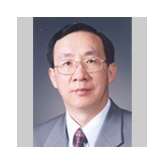-
Development of high power/high energy/high repetition rate beam combination laser using stimulated Brillouin scattering phase conjugate mirrors
Since laser was invented, many researchers have made efforts to achieve a laser with the high power / high energy / high repetition rate. However, they have difficulty in realization of the high energy / high power / high repetition rate due to the thermal problem in the laser media. Some researchers therefore suggested a beam combination technique to reduce the thermal load of the big laser media into many small sized ones. To achieve the high energy / high power laser system, the wavefront distortion should be also removed. And it is well known that it can be compensated by a phase conjugation mirror, especially the stimulated Brillouin scattering phase conjugation mirror (SBS-PCM). Therefore, we have proposed the beam combination laser system using SBS-PCMs and developing it now to obtain high power/high energy/high repetition rate.
-
Optical parametric chirped pulse amplification(OPCPA) system
High-power/high-energy laser facilities which have researched laser-using ICF/target experiments, include the main High-Energy-laser amplifier part and the attached femto-second-laser amplifier part. Generally, OPCPA(optical parametric chirped pulse amplification) has some advantages over the traditional multi-pass amplifier (i.e., reduction of gain narrowing, low-level amplified spontaneous emission, low signal-to-noise ratio, low thermal load); nowadays, it is also being researched as the preamplifier of femto-second laser (i.e., as the short-pulse front-end).
-
Nano-fabrication using Two-Photon Absorption by femtosecond laser
As high power laser light such as Ti:Sapphire femto-second laser with ultra short pulse has been developed, many applications have been being studied. Among many interesting nonlinear optical phenomena by the ultra short pulse laser, the two-photon absorption(TPA) is widely used into many applications. Two-photon absorption(TPA) polymerization is an innovative method, so that it cannot only replace the conventional lithography, but also overcome the scale limitation of the rapid prototype. This method will be promising ways of micro/nano-fabrications such as micro diffractive optical elements, nano-machine design, correcting photo-mask, 3-D photonic crystal, 3-D optical storage, 3-D lithography and so on.
-
3-D imaging LIDAR (Light Detection And Ranging) system
We recently starts the development of the 3-D imaging LIDAR(Light Detection And Ranging) system using Geiger-mode APD (Avalanche PhotoDiode) FPA(Focal Plane Array). This system requires high technologies of laser and detector to make it possible to build a three-dimensional laser radar with several attractive features, including capture of an entire 3D image on a single laser pulse, tens of thousands of pixels, high frame rate, few-centimeter range resolution, and small size.
-
Optical design
We design, analyze, and optimize optical systems using CODE V, LightTools. CODE V, a product of Optical Research Associates, is an advanced engineering application for the design and analysis of optical systems (lenses) of all kinds. LightTools is a unique optical engineering and design software product that features virtual prototyping and simulation of precision illumination applications.
-
Medical infra-red laser
Research of the medical infra-red laser in 3-μm range has been mainly performed for new sources that are strongly absorbed by water and bone. Also, Q-switched giant pulse which is shorter than the thermal relaxation time of a tissue is used for the medical applications such as dental scaling. We work to increase the high pumping-efficiency, the low threshold and the high switching-efficiency. Currently, the slope efficiency of 0.175 % has been achieved in a free-running regime by a specially designed resonator with a dichroically coated rear-mirror. Also, the single pulse energy is more than 48 mJ with its slope efficiency of 0.131 % has been achieved with the frustrated total internal reflection(FTIR) Q-switcher, and their pulse duration is 80 ns.
|

![]()
![]()
![]()
![]()
![]()
![]()







